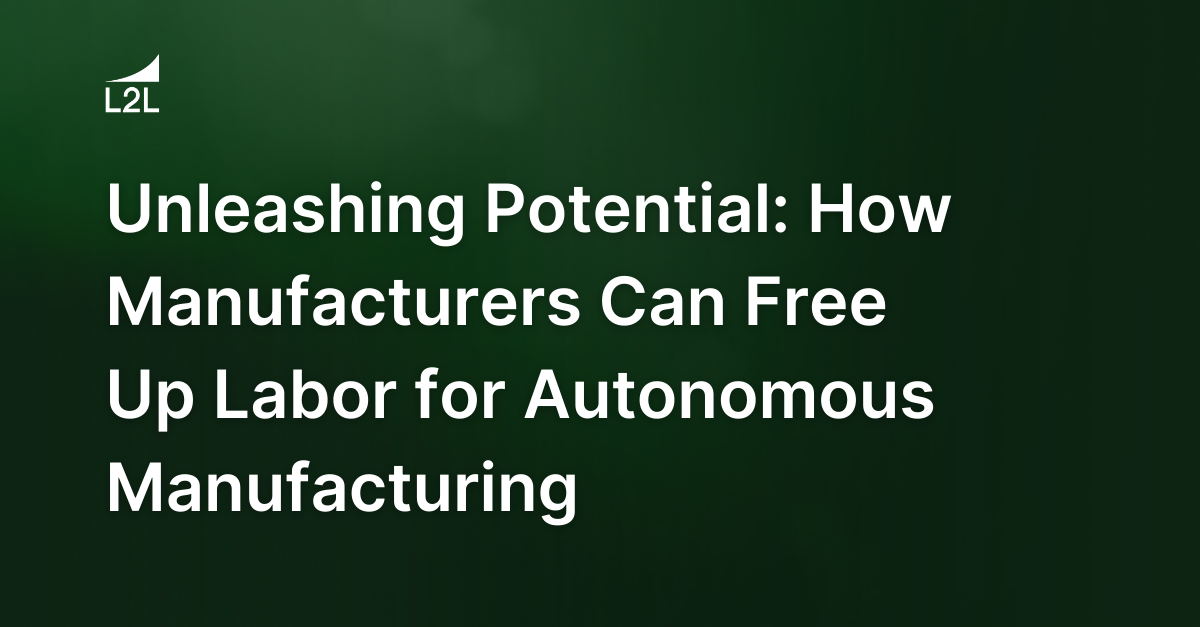
In today's manufacturing sector, the push towards Autonomous Manufacturing represents a significant shift towards more efficient, agile, and intelligent production systems. However, this shift is currently hampered by a critical labor shortage that limits the ability of manufacturers to innovate and fully embrace digital transformation initiatives.
At L2L, we understand that addressing this challenge is not just about filling jobs but about rethinking how labor is utilized on the shop floor. This blog post will explore how manufacturers can strategically free up labor to accelerate their journey toward Autonomous Manufacturing.
The labor constraint in modern manufacturing
The manufacturing labor shortage is not a temporary hurdle but a systemic issue that requires a strategic approach to resolve. Current industry dynamics, characterized by a high turnover rate and a shrinking pool of skilled workers, have placed immense pressure on manufacturers to maintain productivity with fewer resources. This has led to a cycle where seasoned professionals are overwhelmingly focused on maintaining existing processes rather than driving innovation.
Effective change management is essential for overcoming these challenges.
As highlighted at the LNS IX conference held in October 2023, training, process compliance, and managing change are pivotal to breaking the cycle of labor-knowledge churn. The ability to implement meaningful changes hinges on freeing up your workforce to focus on continuous improvement rather than mundane production and maintenance tasks.
How L2L facilitates labor optimization
At L2L, we offer tools and strategies designed to optimize the use of labor and enable manufacturers to pursue more ambitious projects, such as the transition to Autonomous Manufacturing. Here are some steps and methodologies we promote:
Step 1: Implement the L2L Connected Workforce Platform
The L2L Connected Workforce Platform is engineered to enhance both human processes and machine uptime. By addressing common manufacturing problems, L2L not only improves productivity and throughput but also reduces scrap rates, leading to better financial outcomes. Additionally, the platform's focus on continuous improvement helps free up labor by streamlining operations and eliminating unnecessary tasks.
Step 2: Focus on labor-specific metrics
To effectively manage and optimize labor, it's crucial to monitor metrics such as Labor Minutes Per Unit (LMPU), Man Hours, and Labor Efficiency. These metrics help manufacturers assess the impact of organizational, process, and automation changes in labor usage. By prioritizing work that eliminates waste and repetitive tasks, manufacturers can reallocate their workforce towards higher-value activities.
Step 3: Standardize processes and improve communication
Standardizing processes is key to reducing the effort required to manage operations. By removing political barriers and reducing perceived risks among C-level executives, L2L helps facilitate the adoption of more streamlined and efficient practices. Enhanced communication tools and training provided by L2L ensure that workers have the information they need to make informed decisions quickly, further improving labor efficiency.
The snowball effect of labor optimization
By focusing on improving labor metrics and efficiency, manufacturers can create a snowball effect. Freed-up labor can be redeployed to projects that further reduce labor dependencies, such as implementing more advanced AI and automation technologies. This not only addresses the immediate challenges posed by the labor shortage but also positions manufacturers to take full advantage of the benefits of Autonomous Manufacturing.
As manufacturers progress in their digital transformation journeys, the role of Autonomous Manufacturing becomes increasingly central. This new era of manufacturing is defined by machines and AI-driven systems that enhance human capabilities, allowing for more strategic and less labor-intensive involvement in production processes.
Future-proof your manufacturing operations with L2L
To navigate the challenges of today's labor market and to prepare for the future of manufacturing, it's crucial to leverage tools that optimize labor use and enhance operational efficiency. L2L empowers you to transform your labor challenges into opportunities for innovation and growth.
Reach out to sales@l2l.com or schedule a demo with our team to learn how our solutions can help you free up labor and accelerate your path to Autonomous Manufacturing.
Revisions
Original version: 19 June 2024
Written by: Tyler Whitaker
Reviewed by: Daan Assen
Please read our editorial process for more information
Related Posts
Subscribe to Our Blog
We won't spam you, we promise. Only informative stuff about manufacturing, that's all.
